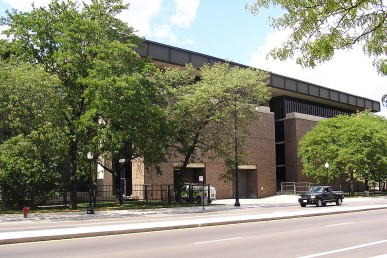Science complex retrofit to cut energy use 30 percent
An energy retrofit at a science complex at the University of Illinois at Chicago is expected to reduce energy consumption by at least 30 percent and save $1.8 million annually.

Science and Engineering Laboratories complex at Taylor and Halsted streets. (Click on image for larger size)
The energy efficiency and infrastructure upgrades throughout the Science and Engineering Laboratories Complex will affect four laboratory buildings and a supporting office building, totalling more than 1.2 million square feet. Four of the buildings date from the mid-1960s.
“We expect the project to yield immediate cost savings for UIC, but more important is that it supports UIC’s Climate Action Plan and will help us meet our goal to reduce our carbon emissions at least 80 percent by 2050,” said UIC Chancellor Paula Allen-Meares.
The project is expected to directly create 592 jobs, according to Ameresco, the energy management company contracting with UIC.
The energy reduction is consistent with the City of Chicago’s Sustainable Chicago 2015 Action Agenda for commercial buildings to reduce energy consumption by at least 20 percent by 2015.
“Energy efficiency is an excellent strategy that saves money, reduces environmental impact and creates jobs,” said Karen Weigert, chief sustainability officer for the City of Chicago. “The Science and Engineering Laboratories Complex, where future leaders in this space will be educated, is a wonderful location for this large project.”
The two-year construction project will include new and recommissioned air handling units, HVAC control systems and equipment, chilled beam, high-performance fume hoods, lighting retrofits, weatherization of the building envelope, and energy recovery systems.
Cynthia Klein-Banai, associate chancellor for sustainability, said the energy reduction of 9,219 metric tons of carbon dioxide is equivalent to taking 1,921 cars off the road or planting 71 acres of trees. The 81 million kilowatt-hours of electricity to be saved is enough to power about 2,500 homes.
“UIC is committed to becoming a more sustainable campus by reducing our environmental impact, generating economic benefit, and creating a more comfortable, healthier environment for the thousands of students, faculty and staff who use those buildings daily,” Klein-Banai said.
UIC ranks among the nation’s leading research universities and is Chicago’s largest university with 27,500 students, 12,000 faculty and staff, 15 colleges and the state’s major public medical center. A hallmark of the campus is the Great Cities Commitment, through which UIC faculty, students and staff engage with community, corporate, foundation and government partners to improve the quality of life in metropolitan areas around the world. For information about UIC, visit www.uic.edu.
